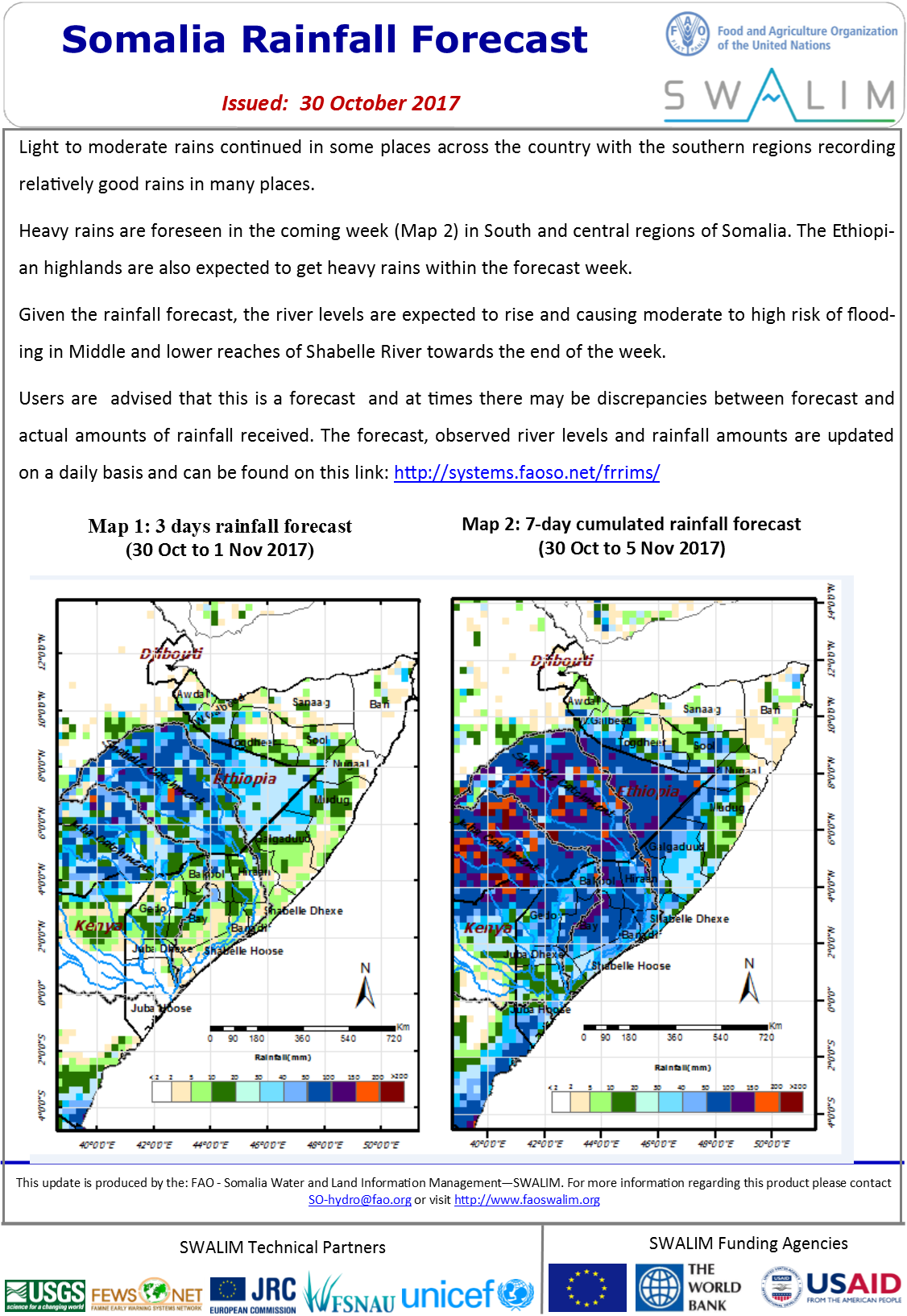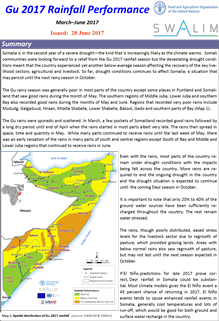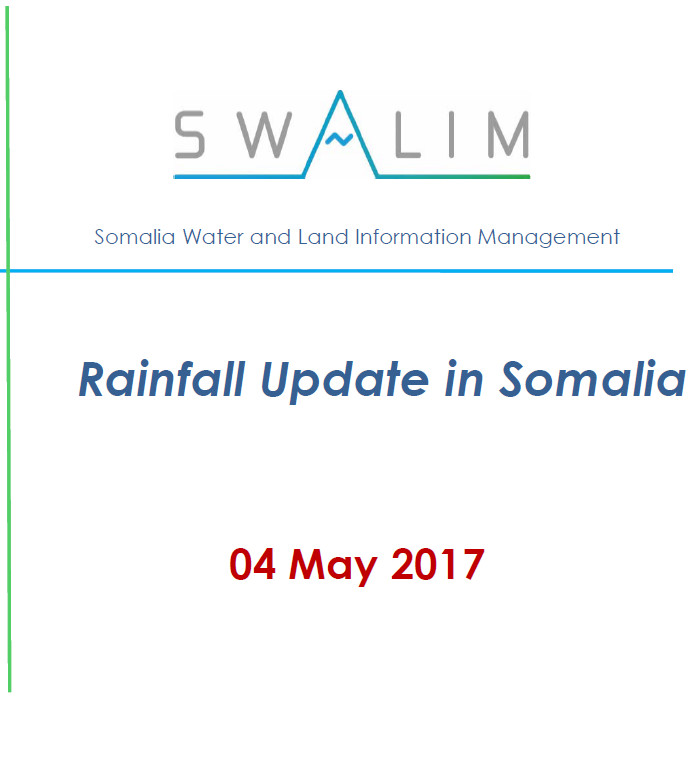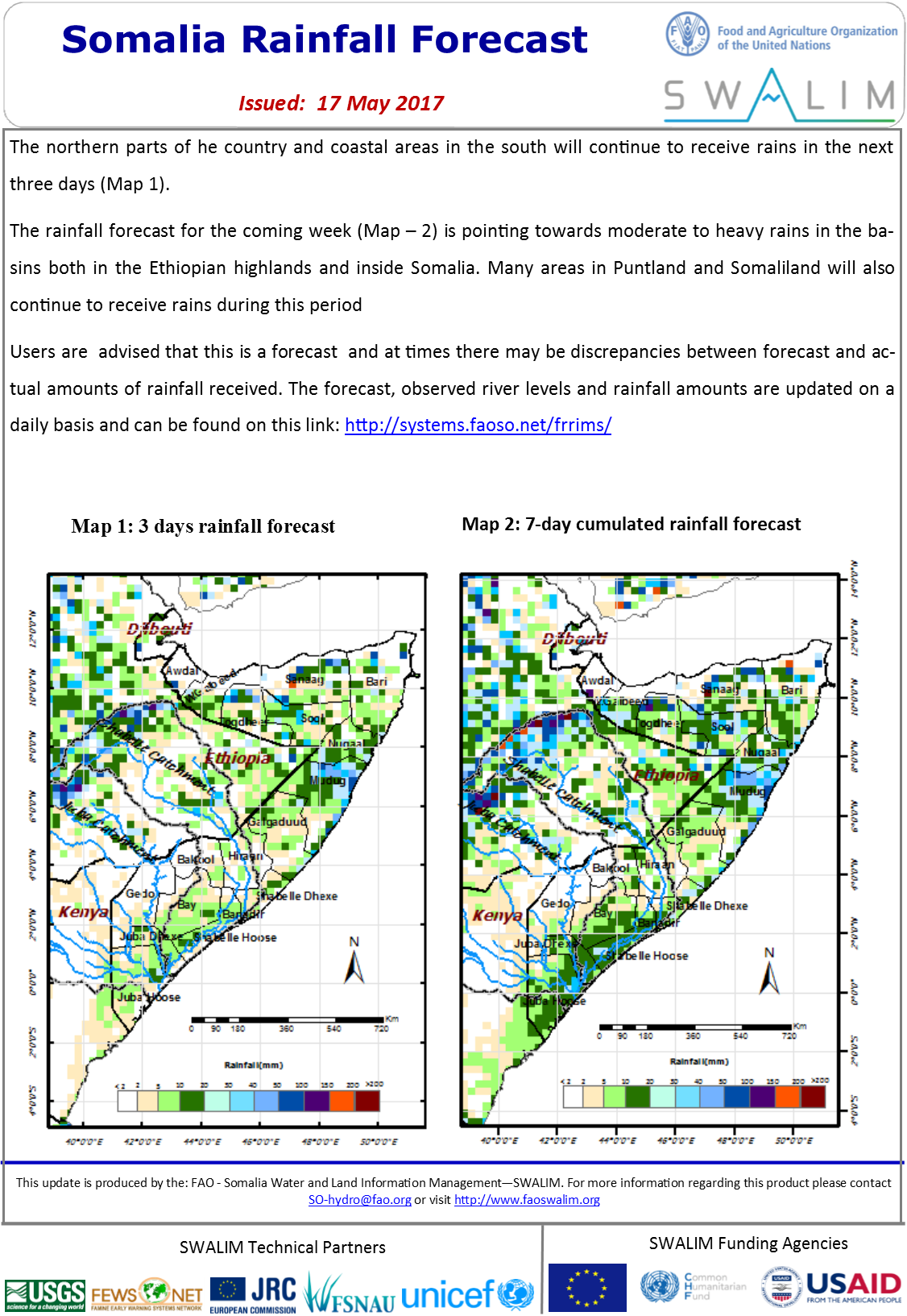Library Catalog
Latest Documents and Publications listed. Use search terms in the box below to find what you need
Somalia Rainfall Forecast 30-10-2017
Light to moderate rains continued in some places across the country with the southern regions recording relatively good rains in many places.
Heavy rains are foreseen in the coming week in South and central regions of Somalia. The Ethiopian highlands are also expected to get heavy rains within the forecast week.
Given the rainfall forecast, the river levels are expected to rise and causing moderate to high risk of flooding in Middle and lower reaches of Shabelle River towards the end of the week.
Publication Type:
Rainfall Forecast
Publication Date:
Author:
Corporate Author:
Somalia Rainfall Forecast 21-09-2017
The three day cumulated rainfall forecast (Map 1) is pointing towards light to moderate rains in scattered areas of the country and this is expected to increase in quantity and space as the week progresses, given the one week forecast (Map 2). Light rains are also expected in the upper parts of Ethiopian highlands whose rainfall contribute significantly to the river flow in Somalia.
River levels in the middle reach of Shabelle are currently high with a high risk of flooding in Jowhar and its environs.
Publication Type:
Rainfall Forecast
Publication Date:
Author:
Corporate Author:
Deyr 2017 Somalia Rainfall Outlook Bulletin - Issued: 29 August 2017
Normal to below normal rains expected in most parts of Somalia during the Deyr 2017 season.
The Deyr rains are usually shorter and less in quantity than the Gu rains. However, they are beneficial in supporting agricultural activities and boosting water availability for different uses. Generally the season starts in late September and ends in November. Nevertheless, this varies from place to place across the country with the northern parts receiving the rains much earlier than the southern parts.
The Greater Horn of Africa Climate Outlook Forum (GHACOF) has confirmed a drastic reduction of the chances of experiencing an El Nino event during the September to December rainy season. The rainfall forecast indicates that the Deyr 2017 season in Somalia is expected to be normal (40% probability of normal rains) with a tendency of 35 % probability of below normal rains in most parts of the country. This also includes part of the Ethiopian highlands which contribute significantly to both Juba and Shabelle river flow inside Somalia. Further, the southern coastal regions of Lower Juba and Lower Shabelle are expected to experience normal rains (40% probability of normal rains) with a tendency of 35% above normal rains.
This forecast is a consensus forecast designed for a regional audience that addresses the rainfall totals summed over the three-month period from October to December 2017. However, SWALIM and other technical partners will keep updating this forecast for shorter lead time periods and will share with you through the regular bulletins throughout the rainfall season.
Given the existing conditions and the rainfall forecast, problems related to water scarcity are likely to persist especially in the northern parts of the country where the previous three rainy seasons were below normal. There is also potential for human-livestock conflicts over limited water resources in these areas. Close monitoring of the situation and contingency measures are necessary in order to adequately cope with the situation. However, flash floods cannot be ruled out as well as river line flooding due to weak river embankments and artificial river bank breakages for irrigation purposes.
Increased water supply is expected in areas where normal rains will be experienced. In such cases, communities should take advantage of the rains to harvest rain-water for future use, using simple technologies. On the other hand, in case of depressed rains replenishing of the surface water points may be minimal and therefore communities should use the available resources sparingly.
Publication Type:
Rainfall Outlook
Publication Date:
Author:
Corporate Author:
Saadaasha Roob di’idda Soomaaliya ee Deyrta 2017
Roobabka deyrtu inta badan waa ka gaaban yihiin kana tiro yar yihiin kuwa Guga. Hase ahaatee, waxay waxtar u yihiin taageeridda hawlaha waxsoosarka beeraha, daaqa iyo sare kaca biyo u helidda isticmaallada kala duwan. Guud ahaan xilligu wuxuu bilowdaa daba yaaqada Sabteembar wuxuuna dhammaadaa Nofeembar.Si kasta oo ay ahaataba, waa iska bedbedelaa meel ka meel dhammaan dalka iyadoo ay qaybaha Waqooyi roobabka helaan waqti aad uga horreeya qaybaha koofureed.
Shirka wacaalka Saadaasha Cimilada Geeska Afrikada Weyn wuxuu xaqiijiyey inuu hoos u dhac ku yimid fursadda lagula kulmayo dacdo El Nino ah inta lagu jiro bilaha Sebteembar ilaa Diseembar. Saadaasha roob di’iddu waxay muujineysa in xilliga Deyrta ee Soomaaliya laga filanayo uu noqonayo mid caadi ah (40% qiyaastii roobabku waa caadi) iyadoo loo badinyo inay suurtogal tahay in 35% ay roobabku caadiga ka hooseyaan badi qaybaha dalka. Tan waxaa sidoo kale ka mid ah qaybo ka tirsan buuraleyda sare ee Itoobiya oo biyo ku biiriya webiyada Juba iyo Shabeelle ee gudaha Soomaaliya. Waxaa intaa dheer, Gobollo xeebeedka Jubada Hoose iyo Shabeellaha Hoose ayaa waxaa la filayaa in ay la kulmaan roobab caadi ah (40% qiyaastii roobab caadi ah) oo laga yaabo in 35% ay noqdaan wax korreeya roobabka caadiga.
Saadaashani waa saadal la isku afgartay oo loogu talagalay dhageysteyaasha gobolka oo wax ka qabta roobabka wadar ahaan marka isugeeyo muddada saddexda bilood oo ka bilaabmaya Oktoobar ilaa Diseembar 2017. Hase yeeshee, SWALIM iyo la-hawlgaleyaasha kale ee farsameed waxay sii wadi doonaa waafajinta saadaashaan muddooyinka gaagaaban ee soo socda oo waa ay idin lawadaagi doona iyagoo ku soo gudbin doona jariidadaha joogtada ah inta xilli roobaadku uu socdo.
Marka la eego xaaladaha jira iyo saadaasha roob di’idda, waxaa la yaabaa in dhibaatooyin la xiriira biyo yaraan ay ka sii socdaan gaar ahaan qaybaha Waqooyi ee dalka halkaasoo saddexdii xilli roobaad ee hore ay ahaayeen kuwo ka hooseeya heerka caadiga ah. Waxaa sidoo kale jira suurtogal ahaansha qulqulatooyin u dhexeeya bani’aadan-xoolo oo isaga hor imaanaya ilaha biyaha xaddidan oo meelahaas ka jira. Kormeer si dhow loogula socdo xaaladda iyo tallaabooyin wax lagu bedelayo ayaa lagama maarmaan u ah sidii si waxkuool ah wax looga qabto xaaladda. Si kastaba ha ahaatee, meesha lagama saari daadadka butaaca oo ka dhaca iyo sidoo kale khadka webiga fataahaya oo sababtu tahay gebiyada webiga oo daciif iyo daamanka webiga oo loo jebiyo iyadoo looga dan leeyahay in waraab loo adeegsado.
Waxaa laga filayaa in biyo ka helitaanku ka kordho meelaha roobabku ay caadi ka yihiin. Xaaladaha noocaas ah, waa in bulshooyinku ay ka faa’ideystaan roobabka oo hoor-qabsadaan marka ay da’ayaan si ay mustaqbalka u isticmaalaan, iyagoo adeegsanaya farsamooyin fudud. Dhanka kale, hadii ay jiraan roobab hoos u dhacsan waxaa laga yaabaa in dib-u-buuxsamidda meelaha ilaha biyaha dhusha sare ah ay yaraato sidaas awgeed bulshooyinku waa inay khayraadyada biyaha la haysto u isticmaalaan si beekhamin/tashiil leh.
Publication Type:
Rainfall Outlook
Publication Date:
Author:
Corporate Author:
The SWALIM Update Issue 13
Welcome to yet another edition of the SWALIM Update, in this edition we cover; SWALIM Runs Webinar on Land and Water Data Collection Using Low Cost Smartphones in Somalia, SWALIM Maps Prosopis invaded areas in Somaliland, Impacts of river breakages monitoring on communities along Shabelle River, SWALIM Supports the Drought Operation & Coordination Centre (DOCC) in Mogadishu, Monitoring of Charcoal Production in South Central Somalia and the Use of Live Map for Water Sources Information Access in Drought Response.
Publication Type:
Newsletter
Publication Date:
Author:
Corporate Author:
Gu 2017 Rainfall Performance Bulletin
Somalia is in the second year of a severe drought the kind that is increasingly likely as the climate warms. Somali communities were looking forward to a relief from the Gu 2017 rainfall season but the devastating drought conditions meant that the country experienced yet another below-average season affecting the recovery of the key livelihood sectors; agricultural and livestock. So far, drought conditions continues to affect Somalia; a situation that may persist until the next rainy season in October.
The Gu rainy season was generally poor in most parts of the country except some places in Puntland and Somaliland that saw good rains during the month of May. The southern regions of Middle Juba, Lower Juba and southern Bay also recorded good rains during the months of May and June. Regions that recorded very poor rains include Mududg, Galgaduud, Hiraan, Middle Shabelle, Lower Shabelle, Bakool, Gedo and southern parts of Bay (Map 1).
The Gu rains were sporadic and scattered. In March, a few pockets of Somaliland recorded good rains followed by a long dry period until end of April when the rains started in most parts albeit very late. The rains then spread in space, time and quantity in May. While many parts continued to receive rains until the last week of May, there was an early cessation of the rains in many parts of south and central regions except South of Bay and Middle and Lower Juba regions that continued to receive rains in June.
Even with the rains, most parts of the country remain under drought conditions with the impacts being felt across the country. More rains are required to end the ongoing drought in the country and the drought situation is expected to continue until the coming Deyr season in October.
It is important to note that only 20% to 40% of the ground water sources have been sufficiently recharged throughout the country. The rest remain water stressed.
The rains, though poorly distributed, eased stress levels for the livestock sector due to regrowth of pasture, which provided grazing lands. Areas with below normal rains also saw regrowth of pasture, but may not last until the next season expected in October.
If El Niño predictions for late 2017 prove correct, Deyr rainfall in Somalia could be substantial. Most climate models gives the El Niño event a 45 percent chance of returning in 2017. El Niño events tends to cause enhanced rainfall events in Somalia, generally cool temperatures and lots of run-off, which would be good for both ground and surface water recharge in the country.
Publication Type:
Rainfall Performance
Publication Date:
Author:
Corporate Author:
Somalia Rainfall Forecast 09-06-2017
There has been a significant reduction of rainfall activities across Somalia over the last one week marking a possible end of the Gu rainy season in many parts of the country.
Little or no rains are foreseen in the country in the next one week.
Following the reduction of rainfall activities within the Juba and Shabelle River basins both in Ethiopia and Somalia, river levels have been decreasing gradually and are expected to stabilize in the coming week.
There is no foreseen risk of flooding along the two rivers.
Publication Type:
Rainfall Forecast
Publication Date:
Author:
Corporate Author:
Somalia Rainfall Update - March to 04 May 2017
The Gu rainy season kicked off in the last week of March in some areas of Somaliland including southern parts of Awdal, Woqooyi Galbeed and Togdheer regions. The March rains were poorly distributed in terms of space and time, but provided an immediate relief to water stressed areas.
The month of April saw a reduction of rainfall activities with most stations recording below normal rains for the month. There was a relief in the last week of April when heavy rains were observed in many areas. A few stations continued to receive rains in the beginning of May especially in Togdheer region.
In general, despite the good short lived rains, the amounts so far received in Somaliland are below average and not adequate to support the current water stress in the area. More rains with good distribution are required to end water scarcity.
The Forecast for the coming two weeks calls for continued rains in the area especially in Woqooyi Galbeed and Togdheer regions.
River levels along the two rivers inside Somalia have subsequently been rising since the last two weeks with the rising trend set to continue in the coming weeks.
Publication Type:
Rainfall Performance
Publication Date:
Author:
Corporate Author:
Somalia Rainfall Forecast 17-05-2017
The northern parts of he country and coastal areas in the south will continue to receive rains in the next three days.
The rainfall forecast for the coming week is pointing towards moderate to heavy rains in the basins both in the Ethiopian highlands and inside Somalia.
Many areas in Puntland and Somaliland will also continue to receive rains during this period
Publication Type:
Rainfall Forecast
Publication Date:
Author:
Corporate Author:
Somalia Rainfall Forecast 09-05-2017
Light to moderate rains continued to be received in a few places across the country in the last two days. The rains are expected to continue in most parts of the country in the next seven days. The rainfall forecast for the coming week (Map 2), indicates moderate to heavy rains in Somaliland and Puntland. Light to moderate rains are foreseen in the southern parts while central regions are expected to remain dry during the same period.
The Ethiopian highlands are also expected to continue receiving rains during the same period. This is will turn lead to a further increase in river levels along the Juba and Shabelle Rivers. Riverine flooding has been reported in Middle reaches of the Shabelle River due to existing open river banks and weak river embankments. There remains a moderate risk of flooding in middle and lower reaches of Shabelle. No risk of flooding is foreseen along the Juba.
Users are advised that this is a forecast and at times there may be discrepancies between forecast and actual amounts of rainfall received.
Publication Type:
Publication Date:
Author:
Corporate Author:
Pages
 RSS feed [compliant with the Agris AP] |
RSS feed [compliant with the Agris AP] |  Agris AP XML
Agris AP XML









